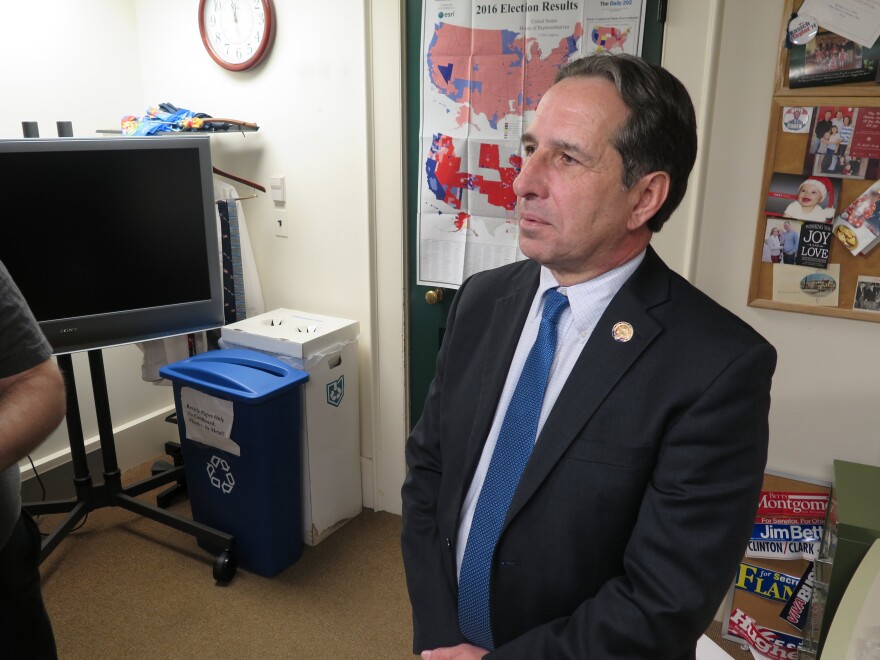House Republicans have offered their own budget plan after seeing tax revenues come up short month after month. The changes include taking out nearly all of Gov. John Kasich’s tax reform proposals.
In his last two budgets Gov. John Kasich has proposed a plan that makes reductions to the income tax, saying he wants to shift the state away from relying on income taxes.
The administration says Ohio has seen a net income tax reduction of $5 billion in the last five years. But sales and other taxes have gone up. In this budget, which will be his last, Kasich introduced a plan that would cut the income tax by 17% while raising the sales tax by 9%.
But Republican House leaders have taken out nearly all of Kasich’s tax proposals this time. House Speaker Cliff Rosenberger joined Kasich and Republican Senate President Larry Obhof of Medina earlier this month for an announcement that $800 million would have to be cut from the budget.
Though Rosenberger has helped lead the way for income tax cuts in the past, he now says this is not the time to continue on that path.
“This is a time to focus on restraint and continue to focus on the foundation of the state so those jobs can continue to be created in our current climate,” Rosenberger said.
Democratic Representative Jack Cera of Bellaire says he’s happy to see the tax shifts taken out of the budget.
“It’s great that they finally got to that conclusion but I think they only did so because of the reduced revenue that has been caused by their tax policies,” he said.
Rosenberger and Republican House Finance Chair Ryan Smith of Bidwell defend their role in cutting taxes in Ohio and say those cuts have helped create jobs.
Smith plans to have the budget out of his committee by early next week.

More money for education and fighting opioids
The Ohio House’s version of the two-year budget also adds more than $170 million to fight Ohio’s opioid crisis and adds $80 million for the state’s K-12 schools.
Ohio House Republicans plan, in their budget, to spend $130 million for treatment, including $20 million for detox and treatment centers, $27 million for county addiction services and $12 million for transitional housing. And House Finance Chairman Ryan Smith says more than $12 million would go toward developing a phone app and hotline to help connect people with drug treatment.
“If you think about Uber locating where you are at and then directing you back to a website, let’s just say the ADAMH board’s website since they are providers in every area.”
There are also more than $19 million in this proposal to cover drug courts, $9 million for workforce training programs, $15 million for child protective services and it earmarks $10 million each year from federal pass through dollars to help provide support for families who are caring for children because of the parent’s addiction issues. While the opioid problem received the largest share of funding, Smith says schools also got new money in this budget.
“The K-12 primary and secondary education was our second largest investment in this budget. Having said that, it’s $80 million over the biennium.”
That translates into a $20 increase in per pupil spending and increases a cap on the amount of state funding a school district can receive. This means some districts that are considered to have higher wealth can draw down more state dollars. This increase was expected, since more than half of districts would have received less money under Governor Kasich’s initial budget. For Jack Cera, the lead Democrat on the House Budget panel, the devil is in the details.

“It’s not a lot of money when you also have a problem with the transportation. They didn’t really fix the transportation costs so a number of school districts are still going to lose money under this proposal.”
Cera says while he’s glad schools and the opioid issue appear to get more money in this budget, he’s not sure how many of those dollars are really new.
“In the past, what they’ve done, is they’ve taken parts of mental health to fund it. And then the second question is, is it really enough to have an impact?”
Cera, who wants the state to take money from the state’s rainy day fund to deal with opioid abuse issues, says he’ll be analyzing this budget in the coming days.






